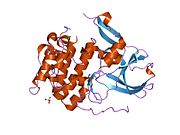Biology:RPS6KA5
From HandWiki
Short description: Enzyme
 Generic protein structure example |
Ribosomal protein S6 kinase alpha-5 is an enzyme that in humans is encoded by the RPS6KA5 gene.[1][2][3] This kinase, together with RPS6KA4, are thought to mediate the phosphorylation of histone H3, linked to the expression of immediate early genes.[4][5]
Interactions
RPS6KA5 has been shown to interact with CREB1.[1][6]
References
- ↑ 1.0 1.1 "Mitogen- and stress-activated protein kinase-1 (MSK1) is directly activated by MAPK and SAPK2/p38, and may mediate activation of CREB". EMBO J 17 (15): 4426–41. September 1998. doi:10.1093/emboj/17.15.4426. PMID 9687510.
- ↑ "Assignment of a member of the ribosomal protein S6 kinase family, RPS6KA5, to human chromosome 14q31→q32.1 by radiation hybrid mapping". Cytogenet Cell Genet 87 (3–4): 261–2. April 2000. doi:10.1159/000015441. PMID 10702687.
- ↑ "Entrez Gene: RPS6KA5 ribosomal protein S6 kinase, 90kDa, polypeptide 5". https://www.ncbi.nlm.nih.gov/sites/entrez?Db=gene&Cmd=ShowDetailView&TermToSearch=9252.
- ↑ Soloaga, Ana; Thomson, Stuart; Wiggin, Giselle R.; Rampersaud, Navita; Dyson, Mark H.; Hazzalin, Catherine A.; Mahadevan, Louis C.; Arthur, J.Simon C. (2003-06-02). "MSK2 and MSK1 mediate the mitogen- and stress-induced phosphorylation of histone H3 and HMG-14". The EMBO Journal 22 (11): 2788–2797. doi:10.1093/emboj/cdg273. ISSN 0261-4189. PMID 12773393.
- ↑ Reul, Johannes M. H. M.; Chandramohan, Yalini (2007-08-01). "Epigenetic mechanisms in stress-related memory formation" (in en). Psychoneuroendocrinology. Integrative approaches to neural plasticity (Lille Summer School, 2006) 32: S21–S25. doi:10.1016/j.psyneuen.2007.03.016. ISSN 0306-4530. PMID 17644269. http://www.sciencedirect.com/science/article/pii/S0306453007001308.
- ↑ Wang, X; Li W; Williams M; Terada N; Alessi D R; Proud C G (August 2001). "Regulation of elongation factor 2 kinase by p90RSK1 and p70 S6 kinase". EMBO J. 20 (16): 4370–9. doi:10.1093/emboj/20.16.4370. ISSN 0261-4189. PMID 11500364.
Further reading
- "STAT3 serine phosphorylation by ERK-dependent and -independent pathways negatively modulates its tyrosine phosphorylation". Mol. Cell. Biol. 17 (11): 6508–16. 1997. doi:10.1128/MCB.17.11.6508. PMID 9343414.
- Jain N; Zhang T; Fong SL et al. (1999). "Repression of Stat3 activity by activation of mitogen-activated protein kinase (MAPK)". Oncogene 17 (24): 3157–67. doi:10.1038/sj.onc.1202238. PMID 9872331.
- New L; Zhao M; Li Y et al. (1999). "Cloning and characterization of RLPK, a novel RSK-related protein kinase". J. Biol. Chem. 274 (2): 1026–32. doi:10.1074/jbc.274.2.1026. PMID 9873047.
- Thomson S; Clayton AL; Hazzalin CA et al. (1999). "The nucleosomal response associated with immediate-early gene induction is mediated via alternative MAP kinase cascades: MSK1 as a potential histone H3/HMG-14 kinase". EMBO J. 18 (17): 4779–93. doi:10.1093/emboj/18.17.4779. PMID 10469656.
- "Serine phosphorylation and negative regulation of Stat3 by JNK". J. Biol. Chem. 274 (43): 31055–61. 1999. doi:10.1074/jbc.274.43.31055. PMID 10521505.
- Buck M; Poli V; van der Geer P et al. (2000). "Phosphorylation of rat serine 105 or mouse threonine 217 in C/EBP beta is required for hepatocyte proliferation induced by TGF alpha". Mol. Cell 4 (6): 1087–92. doi:10.1016/S1097-2765(00)80237-3. PMID 10635333.
- "Regulation of BAD by cAMP-dependent protein kinase is mediated via phosphorylation of a novel site, Ser155". Biochem. J. 349 (Pt 2): 547–57. 2001. doi:10.1042/0264-6021:3490547. PMID 10880354.
- Hefner Y; Borsch-Haubold AG; Murakami M et al. (2001). "Serine 727 phosphorylation and activation of cytosolic phospholipase A2 by MNK1-related protein kinases". J. Biol. Chem. 275 (48): 37542–51. doi:10.1074/jbc.M003395200. PMID 10978317.
- "MSK1 is required for CREB phosphorylation in response to mitogens in mouse embryonic stem cells". FEBS Lett. 482 (1–2): 44–8. 2000. doi:10.1016/S0014-5793(00)02031-7. PMID 11018520.
- Sapkota GP; Kieloch A; Lizcano JM et al. (2001). "Phosphorylation of the protein kinase mutated in Peutz-Jeghers cancer syndrome, LKB1/STK11, at Ser431 by p90(RSK) and cAMP-dependent protein kinase, but not its farnesylation at Cys(433), is essential for LKB1 to suppress cell vrowth". J. Biol. Chem. 276 (22): 19469–82. doi:10.1074/jbc.M009953200. PMID 11297520.
- Deb A; Zamanian-Daryoush M; Xu Z et al. (2001). "Protein kinase PKR is required for platelet-derived growth factor signaling of c-fos gene expression via Erks and Stat3". EMBO J. 20 (10): 2487–96. doi:10.1093/emboj/20.10.2487. PMID 11350938.
- Liu G; Zhang Y; Bode AM et al. (2002). "Phosphorylation of 4E-BP1 is mediated by the p38/MSK1 pathway in response to UVB irradiation". J. Biol. Chem. 277 (11): 8810–6. doi:10.1074/jbc.M110477200. PMID 11777913.
- Wiggin GR; Soloaga A; Foster JM et al. (2002). "MSK1 and MSK2 Are Required for the Mitogen- and Stress-Induced Phosphorylation of CREB and ATF1 in Fibroblasts". Mol. Cell. Biol. 22 (8): 2871–81. doi:10.1128/MCB.22.8.2871-2881.2002. PMID 11909979.
- "Phosphorylation and activation of mitogen- and stress-activated protein kinase-1 in adult rat cardiac myocytes by G-protein-coupled receptor agonists requires both extracellular-signal-regulated kinase and p38 mitogen-activated protein kinase". Biochem. J. 365 (Pt 3): 757–63. 2002. doi:10.1042/BJ20011828. PMID 11994045.
- Toska K; Kleppe R; Armstrong CG et al. (2002). "Regulation of tyrosine hydroxylase by stress-activated protein kinases". J. Neurochem. 83 (4): 775–83. doi:10.1046/j.1471-4159.2002.01172.x. PMID 12421349.
- Strausberg RL; Feingold EA; Grouse LH et al. (2003). "Generation and initial analysis of more than 15,000 full-length human and mouse cDNA sequences". Proc. Natl. Acad. Sci. U.S.A. 99 (26): 16899–903. doi:10.1073/pnas.242603899. PMID 12477932. Bibcode: 2002PNAS...9916899M.
- Janknecht R (2003). "Regulation of the ER81 transcription factor and its coactivators by mitogen- and stress-activated protein kinase 1 (MSK1)". Oncogene 22 (5): 746–55. doi:10.1038/sj.onc.1206185. PMID 12569367.
- Dolled-Filhart M; Camp RL; Kowalski DP et al. (2003). "Tissue microarray analysis of signal transducers and activators of transcription 3 (Stat3) and phospho-Stat3 (Tyr705) in node-negative breast cancer shows nuclear localization is associated with a better prognosis". Clin. Cancer Res. 9 (2): 594–600. PMID 12576423.
 |


